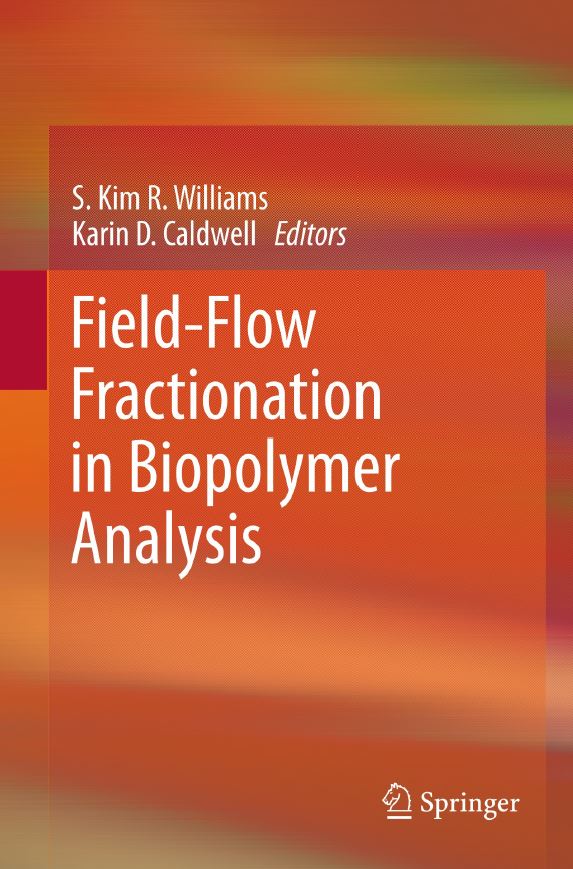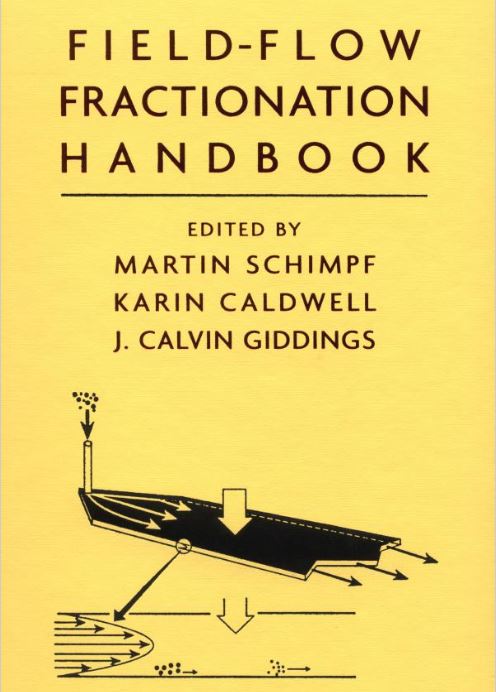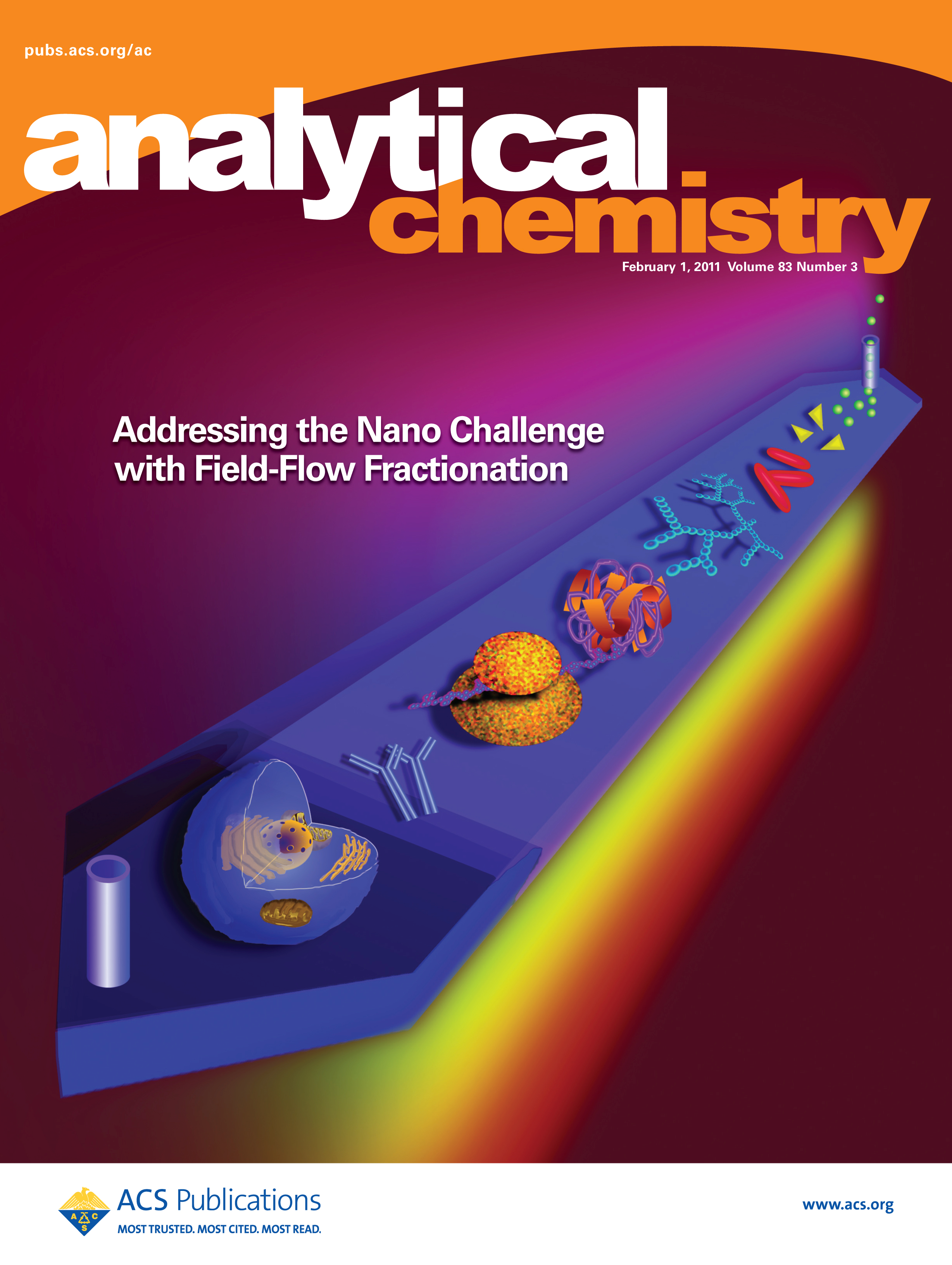Publications
Recent publications
C.L. Plavchak, W.C. Smith, C.R.M. Bria, S.K.R. Williams, New Advances and Applications in Field-Flow Fractionation, Annu. Rev. Anal. Chem. 14 (2021) 257–279. doi:10.1146/annurev-anchem-091520-052742.
Toney, L. Baiamonte, W.C. Smith, S.K.R. Williams, Chapter 4 – Field-flow fractionation techniques for polymer characterization, Molecular Characterization of Polymers – Elsevier, 2021, Pages 129-171, ISBN 9780128197684, https://doi.org/10.1016/B978-0-12-819768-4.00004-X.
W.C. Smith, M. Geisler, A. Lederer, S.K.R. Williams, Thermal Field-Flow Fractionation for Characterization of Architecture in Hyperbranched Aromatic-Aliphatic Polyesters with Controlled Branching, Anal. Chem. 91 (2019) 12344–12351. doi:10.1021/acs.analchem.9b02664.
M. Geisler, W.C. Smith, L. Plüschke, R. Mundil, J. Merna, S.K.R. Williams, A. Lederer, Topology Analysis of Chain Walking Polymerized Polyethylene: An Alternative Approach for the Branching Characterization by Thermal FFF, Macromolecules. 52 (2019) 8662–8671. doi:10.1021/acs.macromol.9b01410.
C.R.M. Bria, F. Afshinnia, P.W. Skelly, T.M. Rajendiran, P. Kayampilly, T.P. Thomas, V.P. Andreev, S. Pennathur, S. Kim R. Williams, Asymmetrical flow field-flow fractionation for improved characterization of human plasma lipoproteins, Anal. Bioanal. Chem. 411 (2019) 777–786. doi:10.1007/s00216-018-1499-3.
C.R.M. Bria, F. Afshinnia, P. W. Skelly, T. M. Rajendiran, P. Kayampilly, T. P. Thomas, V. P. Andreev, S. Pennathur, S.K.R. Williams, “Asymmetrical Flow Field-Flow Fractionation for Improved Characterization of Human Plasma Protein”, Anal. Bioanal. Chem., On-line November 23, 2018. https://doi.org/10.1007/s00216-018-1499-3
W.C. Smith, J. Morse, C. Bria, S.K.R. Williams, “Composition-based separation of Pt-Fe3O4 hybrid nanoparticles by thermal field-flow fractionation”, ACS Appl. Nano Mater., 1, 6435-6443 (2018). DOI: 10.1021/acsanm.8b01643
C.R.M. Bria, J.M. Morse, R. E. Schaak, S. K. R. Williams, “Semi-preparative Asymmetrical Flow Field-Flow fractionation: A Closer Look at Channel Dimensions”,J. Chromatogr. A,1499, 149-157 (2017). DOI: 10.1016/j.chroma.2017.03.017
U. Till,M. Gaucher, B. Amouroux, S. Gineste, B. Lonetti, J.-D. Marty, C. Mingotaud, C. R. M. Bria, S. K. R. Williams, F. Violleau, A.-F. Mingotaud, “Frit inlet field-flow fractionation techniques for the characterization of polyion complex self-assemblies”, Chromatogr. A,1481,101-110 (2017). DOI: 10.1016/j.chroma.2016.12.050
C.R.M. Bria, S. K. R. Williams, “Impactof Asymmetrical Flow-Field Flow Fractionation on Protein Aggregates Stability”, J. Chromatogr.,1465, 155-164 (2016). DOI: 10.1016/j.chroma.2016.08.037
C.R.M. Bria, J. Jones, A. Charlesworth, S. K. R. Williams, “Probing Submicron Aggregation Kinetics of an IgG Protein by Asymmetric Flow Field-Flow Fractionation”, J. Pharm. Sci.,105, 31-39(2016). DOI 10.1002/jps.24703
Featured Articles and Book chapters

This is a timely collection of important biomedical applications for a set of separation/characterization techniques that are rapidly gaining popularity due to their wide dynamic range, high resolution, and ability to function in most commonly used solvent systems. Importantly, the field-flow fractionation (FFF) technique has recently emerged as a prominent complement to size exclusion chromatography for protein pharmaceuticals. Fractionation with FFF is gentle and preserves protein structural integrity better than existing alternatives.

Field flow fractionation (FFF) is an emerging separation technique, which has been proven successful in the analysis of pharmaceuticals, biotechnology products, polymers, soils, and foods, among others. In this book, Martin Schimpf joins forces with Karin Caldwell and J. Calvin Giddings, two of the primary developers of this technique, to bring you the first comprehensive, one-stop reference on the technique.

Field-flow fractionation (FFF) is coming of age as a family of analytical methods for separating and characterizing macromolecules, nanoparticles, and particulates. In their Feature, S. Kim Ratanathanawongs Williams, J. Ray Runyon, and Akram A. Ashames discuss the capabilities and versatility of these techniques in light of the challenges that are being addressed in analyzing nanometer-sized sample components and the insights gained through their use in applications ranging from materials science to biology. The cover, by Robert Gates, shows a graphical representation of a FFF channel and the many types of analytes that can be addressed with the technique.
Publications
2011-2015
J. Bell, J. E. Cloud, J. Cheng, C. Ngo, S. Kodambaka, A. Sellinger, S. K. R. Williams, and Y. Yang, “N-bromosuccinimide-based Bromination and Subsequent Functionalization of Hydrogen-terminated Silicon Quantum Dots”, RSC Adv.,4, 51105 (2014) DOI: 10.1039/C4RA08477B
J. Cheng, S. Rathi, P. Stradins, G. Frey, R. T. Collins, S. K. R. Williams, “Free Standing Silica Thin Films with Highly Ordered Perpendicular Nanopores”, RSC Adv., 4, 7627–7633 (2014). DOI:10.1039/c3ra46666c
Ponyik, C. A.; Wu, D. T.; Williams, S. K. R. Separation and Composition Distribution Determination of Triblock Copolymers by Thermal Field-Flow Fractionation. Anal. Bioanal. Chem. 2013, 405 (28), 9033–9040.
Crawford, N. C.; Williams, S. K. R.; Boldridge, D.; Liberatore, M. W. Shear Thickening of Chemical Mechanical Polishing Slurries under High Shear. Rheol. Acta 2012, 51 (7), 637–647.
Lin, F.; Cheng, J.; Engtrakul, C.; Dillon, A. C.; Nordlund, D.; Moore, R. G.; Weng, T. C.; Williams, S. K. R.; Richards, R. M. In Situ Crystallization of High Performing WO3-Based Electrochromic Materials and the Importance for Durability and Switching Kinetics. J. Mater. Chem. 2012, 22 (33), 16817–16823.
Bell, J. P.; Cloud, J. E.; Cheng, J.; Ngo, C.; Kodambaka, S.; Sellinger, A.; Ratanathanawongs Williams, S. K.; Yang, Y. N-Bromosuccinimide-Based Bromination and Subsequent Functionalization of Hydrogen-Terminated Silicon Quantum Dots. RSC Adv. 2014, 4 (93), 51105–51110.
Runyon, J. R.; Goering, A.; Yong, K. T.; Williams, S. K. R. Preparation of Narrow Dispersity Gold Nanorods by Asymmetrical Flow Field-Flow Fractionation and Investigation of Surface Plasmon Resonance. Anal. Chem. 2013, 85 (2), 940–948.
Crawford, N. C.; Williams, S. K. R.; Boldridge, D.; Liberatore, M. W. Shear Thickening and Defect Formation of Fumed Silica CMP Slurries. Colloids Surfaces A Physicochem. Eng. Asp. 2013, 436, 87–96.
Runyon, J. R.; Williams, S. K. R. A Theory-Based Approach to Thermal Field-Flow Fractionation of Polyacrylates. J. Chromatogr. A 2011, 1218 (39), 7016–7022.
Runyon, J. R.; Williams, S. K. R. Composition and Molecular Weight Analysis of Styrene-Acrylic Copolymers Using Thermal Field-Flow Fractionation. J. Chromatogr. A 2011, 1218 (38), 6774–6779.
2006-2010
S. Kim R. Williams, Leonardo Cinque, and Paul M. Shiundu, “Size Determination of Nanoparticles Used in Coatings”, ACS Symposium Series, Chapter 18, pp 373-395.
D. Lee, S.K.R. Williams, “Thermal field-flow fractionation and multiangle light scattering of polyvinyl acetate with broad polydispersity and ultrahigh molecular weight microgel components“, J. Chromatogr., A 1217, 1667-1673(2010).
S.K.R. Williams, L. Cinque, P.M. Shiundu, “Size Determination of Nanoparticles Used in Coatings“, in Nanotechnology Applications in Coatings, L-P. Sung, R. Fernando, Eds., American Chemical Society, Washington, D.C., 2009.
S.K. Ratanathanawongs Williams, M.A. Benincasa, A.A. Ashames, “Field-Flow Fractionation in Analysis of Polymers and Rubbers”, in Encyclopedia of Analytical Chemistry, eds R.A. Meyers, John Wiley: Chichester. DOI: 10.1002/9780470027318.a2008.pub2. Published 15th December 2009.
C.A. Lohmann, J.E. Engle, W.G. Haseltine, S.K. Ratanathanawongs Williams,”A Rapid Separation Method for Gel Content Determination in Pressure Sensitive Adhesive Dispersions and Acrylic-based Latices for an Industrial Setting”, Anal. Chim. Acta, 654,92-96 (2009).
D. Lee, S. Rumbelow, S.K.R. Williams, “Identification and Quantitation of Trace Impurities in Fatty Alcohol Ethoxylates Using HPLC and MALDI-TOF Mass Spectrometry”, Anal. Chim. Acta, 654, 59-63 (2009).
F.A. Massaud, R.D. Sanderson, J.R. Runyon, T. Otte, H. Pasch, S.K.R. Williams, “An overview on Field Flow Fractionation Techniques and their Applications in the Separation and Characterization of Polymers,” Progress in Polymer Science, 34, 351–368 (2009).
S.K.R. Williams, I. Park, E.E. Remsen, M. Moinpour, “New Metrology for CMP Slurries”, Mater. Res. Soc. Symp. Proc., 991, C-09-01, Materials Research Society (2007).
S.K. Ratanathanawongs Williams, D. Lee, “Field-Flow Fractionation of Proteins, Polysaccharides, Synthetic Polymers, and Supramolecular Assemblies”, J. Sep. Sci., 29, 1720-1732 (2006).
S.K.R. Williams, “Addressing New Challenges in Polymer Analysis Using FFF and MALDI-MS”, Proceedings of the World Polymer Congress – Macro 2006, 41ststt International Symposium on Macromolecules (2006).
D. Lee, S. Kim R. Williams, S. Rumbelow, “Quantification of Poly(ethylene glycol and Poly(propylene glycol) in Alkoxylated Surfactants”, Polymer Preprints, American Chemical Society (2006).
2000-2005
F. Basile, G.E. Kassalainen, S.K.R. Williams, “A Simple Interface for Direct and Continuous Sample-Matrix Deposition onto a MALDI Probe for Polymer Analysis by Thermal Field Flow Fractionation and Off-line MALDI-MS”, Anal. Chem., 77, 3008-3012 (2005).
S. K. Ratanathanawongs Williams, “Separations and Mass Spectrometry: A Symbiotic Relationship”, Proc. 53rd ASMS Conference (2005).
P.M. Shiundu, S.K.R. Williams, “Thermal Field-Flow Fractionation for Particle Analysis:Opportunities and Challenges“, ACS Symp. Ser. 881, Chapter 12, American Chemical Society, Washington, D.C. (2004).
P.M. Shiundu, S.M. Munguti, S.K.R. Williams, “Practical Implications of Ionic Strength in Thermal Field-Flow Fractionation“, J. Chromatogr., 984, 67-79 (2003).
P.M. Shiundu, S.M. Munguti, and S.K. Ratanathanawongs Williams, “Retention Behavior of Metal Particle Dispersions in Aqueous and Nonaqueous Carriers in Thermal Field-Flow Fractionation“ J. Chromatogr., 983, 163-176 (2003).
G. Kassalainen and S.K. Ratanathanawongs Williams, “Coupling Thermal Field-Flow Fractionation and MALDI-TOF Mass spectrometry for the Analysis of Synthetic Polymers“, Anal. Chem., 75, 1887-1894 (2003).
G. Kassalainen and S. K. Ratanathanawongs Williams, “Lowering the Molecular Weight Limit of Thermal Field-Flow Fractionation for Polymer Separations“, J. Chromatogr., 988, 285-295 (2003).
K. R. Williams and G. E. Kassalainen, “Thermal Field-Flow Fractionation as a Polymer Separation Technique for MALDI-TOF MS“, Polymeric Materials: Science & Engineering Preprints., 88, 26 (2003).
H.K. Lee, S. K. Ratanathanawongs Williams, K. L. Wahl, and N. Valentine, “Separation and Identification of Whole Bacteria with Field-Flow Fractionation and MALDI/TOF Mass Spectrometry“, Anal. Chem., 75, 2746-2752 (2003).
R. Hartmann and S.K. Ratanathanawongs Williams, “Flow Field-Flow Fractionation as an Analytical Technique to Rapidly Quantitate Membrane Fouling“, J. Membr. Sci., 209, 93-106 (2002).
S.K. Ratanathanawongs Williams, H.K. Lee, and B. Butler-Veytia, “Determining the Particle Size Distributions of Titanium Dioxide Using Sedimentation Field-Flow Fractionation and Photon Correlation Spectroscopy“ in Service Life Prediction Methodology and Metrologies, J.W. Martin and D.R. Bauer, Eds., ACS Symp. Ser. 805, 2002, ACS, Washington, D.C., pp. 285-298.
P.M. Shiundu, K.R. Williams, “Thermal Field-Flow Fractionation for Particle Analysis: Opportunities and Challenges“, Polymeric Materials: Science and Engineering, 87, 342-344 (2002).
K. R. Williams, G. E. Kassalainen, and F. Basile, “Thermal Field-Flow Fractionation with MALDI-MS For the Analysis of Broad Polydispersity Polymers and Polymer Mixtures“, Proc. 50th ASMS Conf., Orlando, 2002.
G. Kassalainen and S. K. Ratanathanawongs Williams, “Protein Separations by Flow Field-Flow Fractionation“, in Encyclopedia of Chromatography, Chapter 240, pp 680-683, Marcel Dekker, New York, 2001.
H. K. Lee, S. K. Ratanathanawongs Williams, S. Dean Anderson, T. J. Anchordoquy,“Analysis of Self-Assembled Cationic Lipid-DNA Gene Carrier Complexes using Flow FFF and Light Scattering“, Anal. Chem., 73, 837-843 (2001).
Galina E. Kassalainen, S. Kim R. Williams, “Coupling MALDI-TOF MS with Thermal Field-Flow Fractionation (ThFFF) for the Analysis of Synthetic Polymers“, Proc. 49th ASMS Conf., Chicago, 2001.
S. K. Ratanathanawongs Williams, “Flow FFF”, in Field-Flow Fractionation Handbook, M.E. Schimpf, K.D. Caldwell, and J.C. Giddings, eds., Wiley Science, Chapter II-11 (2000).
S. K. Ratanathanawongs Williams and J. C. Giddings, “Sample Recovery” in Field-Flow Fractionation Handbook, M.E. Schimpf, K.D. Caldwell, and J.C. Giddings,eds., Wiley Science, Chapter II-7 (2000).
S. K. Ratanathanawongs Williams and M. A. Benincasa, “Field-Flow Fractionation Analysis of Polymers and Rubbers“, in Encyclopedia of Analytical Chemistry: Instrumentation and Applications, Wiley, 2000.
S. Saenton, H.K. Lee, Y. Gao, J. Ranville, and S. K. Ratanathanawongs Williams, “Evaluation of Different Field-Flow Fractionation Techniques for Separating Bacteria“, Sep. Sci. Technol., 35, 1761-1775 (2000).
1981-1999
S. K. Ratanathanawongs Williams, H. K. Lee, and M. M. Turner, “Size Characterization of Magnetic Cell Sorting MicroBeads Using Field-Flow Fractionation and Photon Correlation Spectroscopy“, J. Magnetism & Magnetic Materials, 194, 248-53 (1999).
H. Lee, K. Ratanathanawongs Williams, and J. C. Giddings, “Particle Size Analysis of Dilute Environmental Colloids by Flow Field-Flow Fractionation Using an Opposed Flow Sample Concentration Technique”, Anal. Chem., 70, 2495-2503 (1998).
S. K. Ratanathanawongs Williams, G. M. Raner, W. E. Ellis, Jr., and J. C. Giddings,“Separation of Protein Inclusion Bodies from E. coli Cell Lysates Using Sedimentation Field-Flow Fractionation”, J. Microcol. Sep., 9, 233-239 (1997).
S. K. Ratanathanawongs Williams and R. G. Keil, “Monitoring Biological and Physical Reactivity of Dextran Carbohydrates in Seawater Incubations Using Flow Field-Flow Fractionation”, J. Liq. Chromatogr. & Rel. Technol., 20, 2815-2833 (1997).
S. K. Ratanathanawongs Williams, “Field-Flow Fractionation of Macromolecules: Principles and Practice”, Proceedings from the Second International Conference on Molecular Mass Characterization of Synthetic and Natural Polymers, Bradford University Research Ltd., United Kingdom, 1996.
K. D. Jensen, S. K Ratanathanawongs Williams, and J. C. Giddings, “High Speed Particle Separation and Steric Inversion in Thin Flow Field-Flow Fractionation Channels”, J. Chromatogr., 746, 137-45 (1996).
M. E. Schimpf, S. K. Ratanathanawongs, and M. E. Hansen, “Size-based Characterization of Industrial Materials by Field-Flow Fractionation Adv. Powder Metall. Part. Mater.“, 1, 203-213 (1995).
A. M. Botana, S. K. Ratanathanawongs, and J. C. Giddings, “Field Strength Programming in Flow Field-Flow Fractionation”, J. Microcol.Sep., 7, 395-402 (1995)
S. K. Ratanathanawongs, P. M. Shiundu, and J. C. Giddings, “Size and Compositional Studies of Core-Shell Latexes Using Flow and Thermal Field-Flow Fractionation”, Colloids and Surfaces A: Physicochem. Eng. Aspects, 105, 243-50 (1995).
S. K. Ratanathanawongs and J. C. Giddings, “Characterization of Core-Shell CarboxylatedLatexes Using Sedimentation and Flow Field-Flow Fractionation”, Polymeric Materials: Science and Engineering Preprints, 70, 26-7 (1994).
J. C. Giddings, S. K. Ratanathanawongs, G. Liu, B. Tjelta, M. H. Moon, M. E. Hansen, and B. N. Barman, “Characterization of Colloidal and Particulate Silica by Field-Flow Fractionation”, Chapter 16 in The Colloid Chemistry of Silica (Advances in Chemistry Series No. 234), pp. 309-340, H. Bergna, Ed., American Chemical Society, Washington, D.C., 1994.
S. K. Ratanathanawongs and J. C. Giddings, “Rapid Size Characterization of Chromatographic Silicas by Flow Field-Flow Fractionation”, Chromatographia, 38, 545-54 (1994).
S. K. Ratanathanawongs and J. C. Giddings, “Particle Size Analysis Using Flow Field-Flow Fractionation”, Chapter 2 in Chromatography of Polymers: Characterization by SEC and FFF (ACS Symposium Series Volume No. 521), pp. 13-29, T. Provder, Ed., American Chemical Society, Washington D.C., 1993.
S. K . Ratanathanawongs and J. C. Giddings, “Dual Field and Flow Programming in Lift Hyperlayer Field-Flow Fractionation”, Anal. Chem., 64, 6-15 (1992).
S. K. Ratanathanawongs and J. C. Giddings, “Particle Size Analysis Using Flow Field-Flow Fractionation”, Polymeric Materials: Science and Engineering Preprints, 65, 24-26 (1991).
J. C. Giddings, S. K. Ratanathanawongs, and M. H. Moon, “Field-Flow Fractionation: A Versatile Technology for Particle Characterization in the size range 10-3 to 102 Micrometers”, KONA: Powder and Particle, 9, 200-17 (1991).
S. K. Ratanathanawongs and J. C. Giddings: “Separation and Characterization of 0.01 – 50 mm Particles Using Flow Field-Flow Fractionation”, pp. 229-46, Chapter 15 in Particle Size Distribution II (ACS Symposium Series Volume No. 472), T. Provder, Ed., American Chemical Society, Washington D.C., 1991.
S. K. Ratanathanawongs and J. C. Giddings, “Particle Size Characterizations from 0.01 um to 50 um by Flow Field-Flow Fractionation”, Polymeric Materials: Science and Engineering Preprints, 62, 181-185 (1990).
S. K. Ratanathanawongs and J. C. Giddings, “High Speed Separation of HPLC Silica by Flow/Hyperlayer Field-Flow Fractionation”, J. Chromatogr., 467, 341-56, (1989).
C. L. M. Stults, P. R. Kraus, S. K. Ratanathanawongs, C. J. Patton and S. R. Crouch, “Comparison of Continuous Flow Analysis Techniques”, J. Chem. Ed., 66, 1060-62 (1989).
S. K. Ratanathanawongs and S. R. Crouch, “Development of a Selective Post-column Detector for Phenols Separated by High Performance Liquid Chromatography”, Anal. Chim. Acta, 192, 277-87 (1987).
T. Szell, A. Brandt and S. Ratanathanawongs, “Two New Thiachalcones“, J. Chem. Eng. Data, 26, 230 (1981).